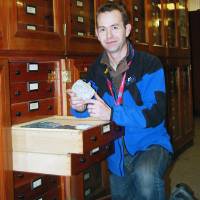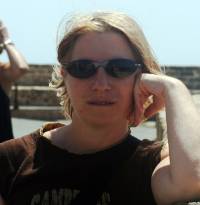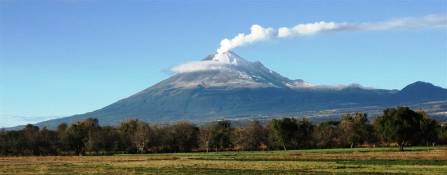By the time you read this I will be well on the way to the Popocatepetl, perhaps even there already... so while I and the rest of the team start preparing for the real work on the most active volcano in Mexico, here's the who's who of the Museum staff on this Field work with Nature Live trip. Let's start with the people here to do the fun stuff, the scientists:
Chiara Maria Petrone is Research Leader in Petrology, a branch of geology that studies the origin, composition, distribution and structure of rocks. In this role she leads the Museum research on active volcanoes and the generation of igneous rocks. What drives this research is to understand how active volcanoes work and to study the rocks to gain insight into their future activity. Likening her work to psychology, she strives to discover the hidden history of the volcano, from the initial magma formation and mineral crystallization till the final eruption.
She has a PhD in Igneous Petrology from the University of Florence, studied Mexican volcanic rocks as a post-doc fellow at the University of Kyoto (Japan) and at the Carnegie Institute of Washington DC (U.S.A) Since studying her PhD, Chiara has developed a wide knowledge of the volcanism of the Trans-Mexican Volcanic Belt, where Popocatepetl is situated.
Her C.V. is positively strewn with active volcanoes including Stromboli (Italy), Santorini (Greece), Vesuvius (Italy) and the Mexican Volcanic arc and she bravely giggles when one highlights the dangers of a volcano like Popo. It’s new to Chiara and she’s keen to climb and study it. Hers is a truly exciting journey to follow.
 David Smith has a Masters in Geology and joined the Museum nearly 20 years ago. His official title is Petrology Collections Manager and he is responsible for the care and preservation of approximately 200,000 rocks and ocean sediments. Want access to material in the collection? Dave’s your man. The Museum’s Collections are in incredible order due to Dave’s deft curation but the work required on these vast numbers could keep Dave busy for another twenty years. And STILL not be completed.
David Smith has a Masters in Geology and joined the Museum nearly 20 years ago. His official title is Petrology Collections Manager and he is responsible for the care and preservation of approximately 200,000 rocks and ocean sediments. Want access to material in the collection? Dave’s your man. The Museum’s Collections are in incredible order due to Dave’s deft curation but the work required on these vast numbers could keep Dave busy for another twenty years. And STILL not be completed.
Occasionally Dave appears on television showing specimens from historical expeditions and how they are used to enhance scientific knowledge today. The interest in the collection is not only from research scientists but artists too. Whenever he gets a chance, Dave likes to take photographs.
His subject interest is wide but he but prefers graphic architecture and abstract imagery. The latter I know because he first provided me with a blog photo you couldn’t see his face in. Once a year he teams up with three friends to form a rowing crew called 'The Muppets' for a Berkshire Regatta. Wearing the appropriate wig, Dave is 'Animal.' I cannot wait to see his fieldwork outfit.
And now your intrepid reporters:
 Lee Quinn has been part of the special effects team at the Museum for seven years with an applied arts degree from Camberwell College and a BA in special effects from South Bank Uni. Specialising in audio, he provides the most entertaining of his own on work assignments with his animated chat and if you've ever visited exhibitions such as our Wildlife Photographer of the Year, you'll have heard the soundscapes he's composed too.
Lee Quinn has been part of the special effects team at the Museum for seven years with an applied arts degree from Camberwell College and a BA in special effects from South Bank Uni. Specialising in audio, he provides the most entertaining of his own on work assignments with his animated chat and if you've ever visited exhibitions such as our Wildlife Photographer of the Year, you'll have heard the soundscapes he's composed too.
He'll not deny the idea of climbing an active volcano appeals to him, 'I bungeed off a crane in Orlando when they were first invented, so this is a natural progression for me!’
Lastly, I’m Jo Kessler your devoted blogger, camera-shy reporter and member of the Nature Live team at the Museum, blessed with the role of developing events with scientists and presenting them to public and school audiences. Whilst having a lifelong love of the natural world, I spent my first working decade in the music industry, representing hugely talented and inspiring role models. So, little has changed in that respect.
When volunteering at the Museum in 2005 (do it if you can, the rewards are endless) I completed a BA in furniture and product design but soon felt ‘the call of the wild’ and made natural science my career intead. I’m so excited by the science at the Museum my drive is to share it. So, bombard me with your thoughts and burning questions and they’ll be answered (volcano jokes notwithstanding) ...




